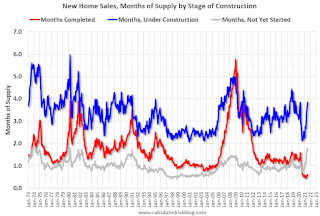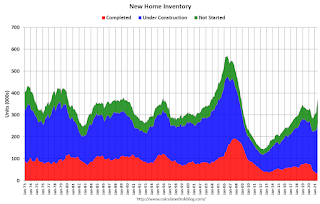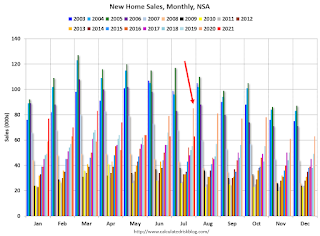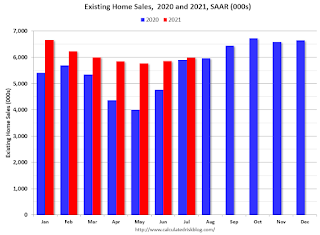by Calculated Risk on 8/24/2021 01:02:00 PM
Tuesday, August 24, 2021
New Home Prices
As part of the new home sales report released this morning, the Census Bureau reported the number of homes sold by price and the average and median prices.
From the Census Bureau: "The median sales price of new houses sold in July 2021 was $390,500. The average sales price was $446,000."
The following graph shows the median and average new home prices.

During the housing bust, the builders had to build smaller and less expensive homes to compete with all the distressed sales. When housing started to recovery - with limited finished lots in recovering areas - builders moved to higher price points to maximize profits.
The average price in July 2021 was a record $446,00, up 18% year-over-year. The median price was a record $390,500, up 18% year-over-year.
The second graph shows the percent of new homes sold by price.
 Very few new homes sold were under $200K in July 2021 (about 1.6% of all homes). This is down from 56% in 2002. In general, the under $200K bracket is going away.
Very few new homes sold were under $200K in July 2021 (about 1.6% of all homes). This is down from 56% in 2002. In general, the under $200K bracket is going away. The $400K and greater than $500K+ brackets increased significantly over the last decade.
A few Comments on July New Home Sales
by Calculated Risk on 8/24/2021 11:13:00 AM
New home sales for July were reported at 708,000 on a seasonally adjusted annual rate basis (SAAR). Sales for the previous three months were revised up, combined.
This was somewhat above consensus expectations for July, but still down 27.2% year-over-year - since sales increased sharply following the early months of the pandemic. The new home sales rate is now slightly below the pre-pandemic level of around 740 thousand (the three months previous to pandemic).
 Click on graph for larger image.
Click on graph for larger image.This graph shows new home sales for 2020 and 2021 by month (Seasonally Adjusted Annual Rate).
The year-over-year comparisons were easy in the first half of 2021 - especially in March and April.
However, sales will likely be down year-over-year for the remainder of 2021 - since the selling season was delayed in 2020.
And on inventory: note that completed inventory (3rd graph in previous post) is near record lows, but inventory under construction is closer to normal.
 This graph shows the months of supply by stage of construction.
This graph shows the months of supply by stage of construction.The inventory of completed homes for sale was at 36 thousand in July, just above the record low of 33 thousand in March, April and May 2021. That is about 0.6 months of completed supply (just above the record low).
New Home Sales Increase to 708,000 Annual Rate in July
by Calculated Risk on 8/24/2021 10:12:00 AM
The Census Bureau reports New Home Sales in July were at a seasonally adjusted annual rate (SAAR) of 708 thousand.
The previous three months were revised up, combined.
Sales of new single‐family houses in July 2021 were at a seasonally adjusted annual rate of 708,000, according to estimates released jointly today by the U.S. Census Bureau and the Department of Housing and Urban Development. This is 1.0 percent above the revised June rate of 701,000, but is 27.2 percent below the July 2020 estimate of 972,000.
emphasis added
 Click on graph for larger image.
Click on graph for larger image.The first graph shows New Home Sales vs. recessions since 1963. The dashed line is the current sales rate.
New home sales are now declining year-over-year since sales soared following the first few months of the pandemic.
The second graph shows New Home Months of Supply.
 The months of supply increased in July to 6.2 months from 6.0 months in June.
The months of supply increased in July to 6.2 months from 6.0 months in June. The all time record high was 12.1 months of supply in January 2009. The all time record low was 3.5 months, most recently in October 2020.
This is above the normal range (about 4 to 6 months supply is normal).
"The seasonally‐adjusted estimate of new houses for sale at the end of July was 367,000. This represents a supply of 6.2 months at the current sales rate."
 On inventory, according to the Census Bureau:
On inventory, according to the Census Bureau: "A house is considered for sale when a permit to build has been issued in permit-issuing places or work has begun on the footings or foundation in nonpermit areas and a sales contract has not been signed nor a deposit accepted."Starting in 1973 the Census Bureau broke this down into three categories: Not Started, Under Construction, and Completed.
The third graph shows the three categories of inventory starting in 1973.
The inventory of completed homes for sale is just above the record low, but the combined total of completed and under construction is close to normal.
 The last graph shows sales NSA (monthly sales, not seasonally adjusted annual rate).
The last graph shows sales NSA (monthly sales, not seasonally adjusted annual rate).In July 2021 (red column), 63 thousand new homes were sold (NSA). Last year, 85 thousand homes were sold in July.
The all time high for July was 117 thousand in 2005, and the all time low for July was 26 thousand in 2010.
This was above expectations of 690 thousand sales SAAR, and sales in the three previous months were revised up, combined. I'll have more later today.
New York State Real Estate in July: Sales Up 22% YoY, Inventory Down 46% YoY
by Calculated Risk on 8/24/2021 08:05:00 AM
Note: I'm tracking data for many local markets around the U.S. I think it is especially important to watch inventory this year.
For New York State:
Closed sales in July 2021 were 13,765, up 32.6% from 10,384 in July 2020.
Active Listings in July 2021 were 44,025, down 19.5% from 54,700 in July 2020.
Inventory in July was up 1.4% from last month, and up 13.5% from the record low in March 2021.
South Florida Real Estate in July: Sales Up 22% YoY, Inventory Down 46% YoY
by Calculated Risk on 8/24/2021 07:54:00 AM
Note: I'm tracking data for many local markets around the U.S. I think it is especially important to watch inventory this year.
For the South Florida area:
Closed sales (house and condos) in July 2021 were 11,792, up 21.8% from 9,685 in July 2020.
Active Listings in July 2021 were 23,724, down 45.6% from 43,586 in July 2020.
Inventory in July was down 7.4% from last month and was at a record low.
Monday, August 23, 2021
Tuesday: New Home Sales, Richmond Fed Mfg
by Calculated Risk on 8/23/2021 09:00:00 PM
From Matthew Graham at Mortgage News Daily: Mortgage Rates Start Higher, But Improve in The Afternoon
By abstaining on Friday, the average lender was forced to adjust today's rates slightly higher to account for the bond market weakness. In other words, this morning's rates were higher than Friday morning's.Tuesday:
As the day progressed, mortgage bonds improved enough for a friendly mid-day reprice. A majority of lenders pulled the trigger, thus helping rates close the gap with Friday's rates. Simply put, rates started the day moderately higher versus Friday morning, but are now only marginally higher (assuming the lender in question offered a mid-day price improvement). ... [30 year fixed 2.94%]
emphasis added
• At 10:00 AM ET, New Home Sales for July from the Census Bureau. The consensus is for 690 thousand SAAR, up from 676 thousand in June.
• Also at 10:00 AM, Richmond Fed Survey of Manufacturing Activity for August.
August 23rd COVID-19: Data reported on Monday is always low, and will be revised up as data is received
by Calculated Risk on 8/23/2021 07:47:00 PM
| COVID Metrics | ||||
|---|---|---|---|---|
| Today | Yesterday | Week Ago | Goal | |
| Percent fully Vaccinated | 51.5% | 51.5% | 50.8% | ≥70.0%1 |
| Fully Vaccinated (millions) | 171.1 | 170.8 | 168.7 | ≥2321 |
| New Cases per Day3 | 124,383 | 133,517 | 130,165 | ≤5,0002 |
| Hospitalized3🚩 | 77,727 | 80,362 | 71,466 | ≤3,0002 |
| Deaths per Day3🚩 | 691 | 725 | 664 | ≤502 |
| 1 Minimum to achieve "herd immunity" (estimated between 70% and 85%). 2my goals to stop daily posts, 37 day average for Cases, Currently Hospitalized, and Deaths 🚩 Increasing 7 day average week-over-week for Cases, Hospitalized, and Deaths ✅ Goal met. | ||||
IMPORTANT: For "herd immunity" most experts believe we need 70% to 85% of the total population fully vaccinated (or already had COVID).
The following 17 states and D.C. have between 50% and 59.9% fully vaccinated: Washington at 59.5%, New Hampshire, New York State, New Mexico, Oregon, District of Columbia, Virginia, Colorado, Minnesota, California, Hawaii, Delaware, Pennsylvania, Wisconsin, Florida, Nebraska, Iowa, Illinois, and Michigan at 50.0%.
Next up (total population, fully vaccinated according to CDC) are South Dakota at 48.4%, Ohio at 47.8%, Kentucky at 47.6%, Kansas at 47.3%, Arizona at 47.1%, Nevada at 46.8%, Utah at 46.7%, and Alaska at 46.6%.
 Click on graph for larger image.
Click on graph for larger image.This graph shows the daily (columns) and 7 day average (line) of positive tests reported.
MBA Survey: "Share of Mortgage Loans in Forbearance Slightly Decreases to 3.25%"
by Calculated Risk on 8/23/2021 04:00:00 PM
Note: This is as of August 15th.
From the MBA: Share of Mortgage Loans in Forbearance Slightly Decreases to 3.25%
The Mortgage Bankers Association’s (MBA) latest Forbearance and Call Volume Survey revealed that the total number of loans now in forbearance decreased by 1 basis point from 3.26% of servicers’ portfolio volume in the prior week to 3.25% as of August 15, 2021. According to MBA’s estimate, 1.6 million homeowners are in forbearance plans.
The share of Fannie Mae and Freddie Mac loans in forbearance decreased 3 basis points to 1.66%. Ginnie Mae loans in forbearance decreased 3 basis points to 3.92%, while the forbearance share for portfolio loans and private-label securities (PLS) increased 10 basis points to 7.15%. The percentage of loans in forbearance for independent mortgage bank (IMB) servicers increased 2 basis points to 3.48%, and the percentage of loans in forbearance for depository servicers decreased 1 basis point to 3.35%.
“The share of loans in forbearance was little changed, as both new requests and exits were at a slower pace compared to the prior week. In fact, exits were at their slowest pace in over a year,” said Mike Fratantoni, MBA’s Senior Vice President and Chief Economist. “There were more new forbearance requests and re-entries for portfolio and PLS loans, leading to a 10-basis-point increase in their share. Portfolio and PLS loans now account for almost 50% of all depository servicer loans in forbearance and almost 40% of IMB servicer loans in forbearance, which highlights the importance of this investor category.”
emphasis added
 Click on graph for larger image.
Click on graph for larger image.This graph shows the percent of portfolio in forbearance by investor type over time. Most of the increase was in late March and early April 2020, and has trended down since then.
The MBA notes: "Total weekly forbearance requests as a percent of servicing portfolio volume (#) decreased relative to the prior week: from 0.06% to 0.05%.%"
Comments on July Existing Home Sales
by Calculated Risk on 8/23/2021 01:11:00 PM
Earlier: NAR: Existing-Home Sales Increased to 5.99 million in July
Two key points:
1) Existing home sales are somewhat above pre-pandemic levels rate of around 5.5 million SAAR (average six months prior to pandemic). Seasonally adjusted (SA) sales for July 2021 were also the highest since 2006 - about 2% above July 2020.
2) Inventory is very low, and was down 12.0% year-over-year (YoY) in July. Also, as housing economist Tom Lawler has noted, the local MLS data shows even a larger decline in active inventory (the NAR appears to include some pending sales in inventory). Lawler noted:
"As I’ve noted before, the inventory measure in most publicly-released local realtor/MLS reports excludes listings with pending contracts, but that is not the case for many of the reports sent to the NAR (referred to as the “NAR Report!”), Since the middle of last Spring inventory measures excluding pending listings have fallen much more sharply than inventory measures including such listings, and this latter inventory measure understates the decline in the effective inventory of homes for sale over the last several months."
 Click on graph for larger image.
Click on graph for larger image.This graph shows existing home sales by month for 2020 and 2021.
The year-over-year comparison will be more difficult in the second half of the year.
The second graph shows existing home sales for each month, Not Seasonally Adjusted (NSA), since 2005.
 Sales NSA in July (584,000) were 2.2% below sales in July 2020 (597,000).
Sales NSA in July (584,000) were 2.2% below sales in July 2020 (597,000). This was the second highest sales for July, NSA, since 2006.
Housing Inventory August 23rd Update: Inventory Increased Week-over-week, Up 41% from Low in early April
by Calculated Risk on 8/23/2021 11:50:00 AM
Tracking existing home inventory will be very important this year.

This inventory graph is courtesy of Altos Research.
Mike Simonsen discusses this data regularly on Youtube.


